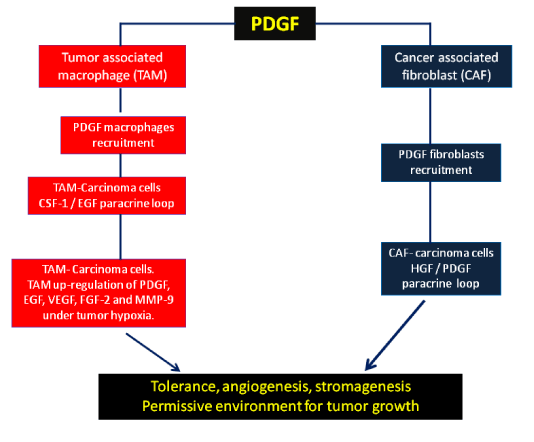
 |
| Figure 3: PDGF interactions and cross-talk in tumorigenesis. As described for wounds, PDGF may create a favorable environment for macrophages and fibroblasts recruitment into the tumor parenchyma. Macrophages-secreted PDGF as by other cells within the tumor recruits more macrophages and activates fibroblasts creating and interactive networking that instructs both cells to act as key players in tumor promotion/progression. As described by Wickoff and Condeelis, a paracrine self-propagating loop is created between tumor macrophages and tumor epithelial cells so that the former secrete EGF, which is a positive stimulus for the malignant epithelial cells that express EGFR. In turn, carcinoma cells secrete CSF-1 which attracts macrophages and induces them to secrete more EGF, thus completing the loop. Another example of tumorperpetuating loop is given by TAMís response to hypoxia, so that growth factors with special tropism for epithelial (EGF), stromal (PDGF, fibroblast growth factor: FGF), and vascular cells (PDGF and vascular endothelial growth factor: VEGF) are released; thus enhancing carcinoma cells survival, stromagenesis by fibroblasts activation and angiogenesis. In this context metaloproteases (MMP) are also released by macrophages which remodel tumor storma. PDGF is involved in another loop which connects CAF and carcinoma cells. CAF secrete hepatocyte growth factor (HGF) which enhances carcinoma cells proliferation and migration. These cells in turn secrete PDGF which is used as activating and mitogenic factor for CAF. |